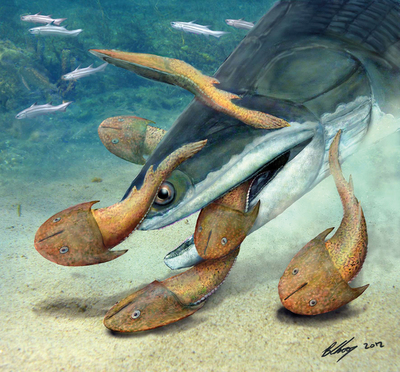| Location: Home > News > Events |
| Nature:Palaeontology: Tracing the backbone in China's rocks |
|
Xu Xing relishes a bilingual book on the evolution of vertebrate life in his fabulously fossil-rich country.
China's rich fossil resources have supplied many firsts — discoveries that have rewritten and helped to construct evolutionary history. The bilingual (English and Chinese) From Fish to Human summarizes and highlights the spectacular Chinese vertebrate fossil record and its place in the broader span of vertebrate life.
Brian Choo Megamastax amblyodus eating Dunyu longiferus, from the 423-million-year-old Xiaoxiang Biota of China.
This volume, rich with illustrations, was produced by an international team of vertebrate palaeontologists. Corwin Sullivan wrote the English text with input from the other authors, Wang Yuan did the Chinese translation and Brian Choo produced the illustrations. (I work alongside all three, but was not involved with this book.) Their effort has produced an excellent resource.
From Fish to Human describes 15 Chinese faunas — collections of fossils of a similar age from the same general area — that highlight every major geological time period from the early Cambrian to the late Pleistocene epoch. The Cambrian Chengjiang Biota, for example, dating to around 525 million years ago, contains the oldest known diverse multicellular animals, including the earliest vertebrates, such as the primitive, fishlike Haikouichthys. It is shedding light on the rapid diversification of life known as the Cambrian explosion.
Flamboyant feathered dinosaurs from the roughly 125-million-year-old Jehol Biota, such as the four-winged Microraptor and the gigantic tyrannosaur Yutyrannus, have garnered much public attention; less known are the earlier Silurian Xiaoxiang and Devonian Zhongning faunas. The authors explain how discoveries from these have helped to establish the evolution of important structures such as jaws and limbs. Entelognathus from Xiaoxiang, for example, is a placoderm, or armoured fish, with the jawed face of an osteichthyan, or bony fish — a finding that blurs the boundary between major vertebrate groups (see Nature http://doi.org/4j4; 2013).
Each fauna or group of faunas is followed by a concise review of a related evolutionary transition. So the discussion of how feathers evolved into their modern form follows a description of the Jehol Biota, which yielded much of the fossil evidence for it.
The balance between specific discoveries and general evolutionary history allows a clear and current understanding of vertebrate evolution, and showcases the beauty of the extinct animals. Thus stunning photographs, for example of the exquisitely preserved fossils from the Chengjiang Biota, sit alongside remarkable reconstructions of creatures and habitats. Informative drawings show the family trees of major vertebrate groups and biological structures such as tetrapod limbs.
I do have quibbles. The chapter on basics such as how fossils form will help beginners, but the rest seems to be written for advanced readers. Discussion of some important groups is missing; for example, we read nothing of the Late Cretaceous Bayan Mandahu Fauna (about 75 million years old), from which significant information on dinosaur behaviour has been recovered. The authors list 79 major vertebrate fossil sites in China — at least 10 short, in my view. They describe only 15.
Attractive global palaeogeographic maps show the arrangement of the continents and oceans in different geological periods, but there is no indication of the modern locations of the fossil faunas in China. Neither is there a summary guide to their stratigraphic distribution. And in a few cases, the Chinese translation is subtly different in meaning and intent from the original English.
Nevertheless, this book should occupy the shelf of anyone eager to keep up with advances in palaeontology and evolution, or to know more about Chinese palaeontology. (By XU Xing, IVPP) |
